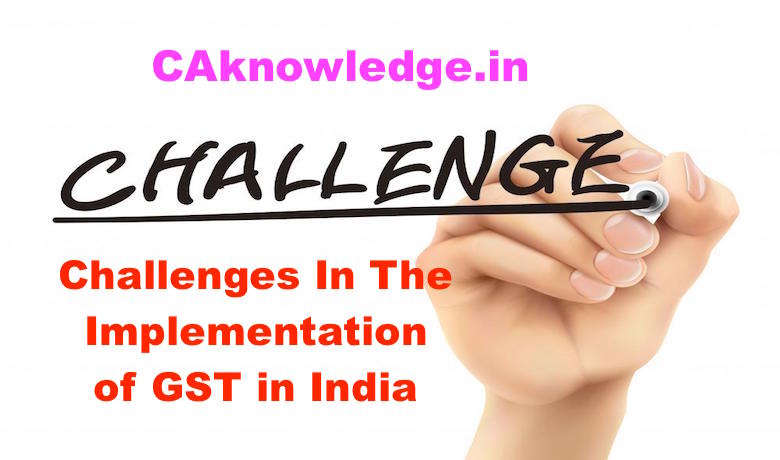Why GST For India – Challenges for Success in India. problem on gst. Presently, the tax structure of India is very complex. Looking to the global developments and tax structure of developed countries. Here we are providing complete details for Why GST For India and GST – Challenges for Success in India. In this article you can find complete details regarding GST in India, Meaning of GST In India, Silent Features of GST. Now you can scroll down below and check complete details regarding “Why GST For India – Challenges for Success in India”
Clause 366(12A) of the Constitution Bill defines GST as “goods and services tax” means any tax on supply of goods, or services or both except taxes on the supply of the alcoholic liquor for human consumption. Further the clause 366(26A) of the Bill defines “Services” means anything other than Goods. Thus it can be said that GST is a comprehensive tax levy on manufacture, sale and consumption of goods and services at a national level. The proposed tax will be levied on all transactions involving supply of goods and services, except those which are kept out of its purview.
If you like this article then please like us on Facebook so that you can get our updates in future ……….and subscribe to our mailing ”freely“
Basic Challenges In The Implementation of GST
- Uniformity
- Increase in compliance cost for business
- Avoidance of cascading effect cornerstone of GST– Seamless Credit– But I ‘See less credit”
- RCM pressure
- legal restrictions
- Discretionary disallowance
- Exemption/ threshold may distort RNR & GST
- Effectiveness of GST Council and adherence to its recommendations
- Efficacy of GSTN
- Tax administration no mention in any policy docs. [refer Shome Committee’s 1st Report, 2014]
Why GST For India – Challenges for Success in India
Presently, the tax structure of India is very complex. Looking to the global developments and tax structure of developed countries, GST is the need of the hour. The need of GST can further be explained in the following points:-
- There are various definitional issues related to manufacturing, sale, service, valuation etc. arises. These needs to be rationalized.
- Several transactions take the character of sales as well as services, thus there is complexity in determining the nature of transaction.
- The mechanism of imposing taxes, exemptions, abatements, other benefits are different in state and centre
- Existing law has resulted in significant number of issues related to interpretation or various provisions and the category of the products and the nature of services.
- Administration mechanics of the centre and state and even in different states is different.
- India needs comprehensive levy and collection on both goods and services at the same rate with the benefit of input credit
- A simple tax structure can bring greater compliance, thus increasing number of tax payers and in turn tax revenues of Government.
- GST will ensure competitive pricing. Tax paid by final consumer will come down in most cases. Lower prices will help in boosting consumption which is beneficial to Companies.
- GST will ensure boost to exports. When the cost of Production falls in the domestic market, Indian Goods and services will be more pricecompetitive in foreign markets
- The current state of Indian Economy demands fiscal consolidation and reduction in Fiscal deficit. A recent Report By CRISIL states that GST is the country’s best bet to achieve fiscal consolidation.
GST – Challenges for Success in India
Advertisement
GST will be the biggest reform in Indian taxation since 1947, but there are many challenges for its successful implementation. These are as under
- Passing of Bill in Rajya Sabha: Since Central Government is not having sufficient majority in the Rajya Sabha. Thus, it will have to ensure safe passage as it will not be cake-walk for the Union government to pass the Bill in the Upper House of Parliament.
- Consent of States: For implementing it is critical that GST bill is passed by the respective state Governments in state assemblies so as to bring majority. This is a herculean task.
- Revenue Neutral Rate (RNR): It is one of Prominent Factor for its success. We know that in GST regime, the government revenue would not be the same as compared to the current system. Hence, through RNR Government is to ensure that its revenue remains the same despite of giving tax credits.
- Threshold Limit in GST: While achieving broad based tax structure under GST, Both empowered committee and Central Government must ensure that lowering of threshold limit should not be a “taxing” burden on small businessmen in the country
- Robust IT Network: Government has already incorporated Goods and service tax network (GSTN). GSTN has to develop GST portal which ensure technology support for GST Registration, gst return filing, tax payments, IGST settlements etc. Thus there should be a robust IT backbone
- Extensive Training to Tax Administration Staff: GST is absolutely different from existing system. It, therefore, requires that tax administration staff at both Centre and state to be trained properly in terms of concept, legislation and Procedure.
- Additional Levy on GST: The Purpose of additional Levy is to compensate states for loss of revenue while moving to GST. We acknowledge that fundamental purpose of GST is to make “INDIA” as one state where inter-state movement of goods is common. In this situation, it would defeat the very purpose of GST in the country.
Must Read –
